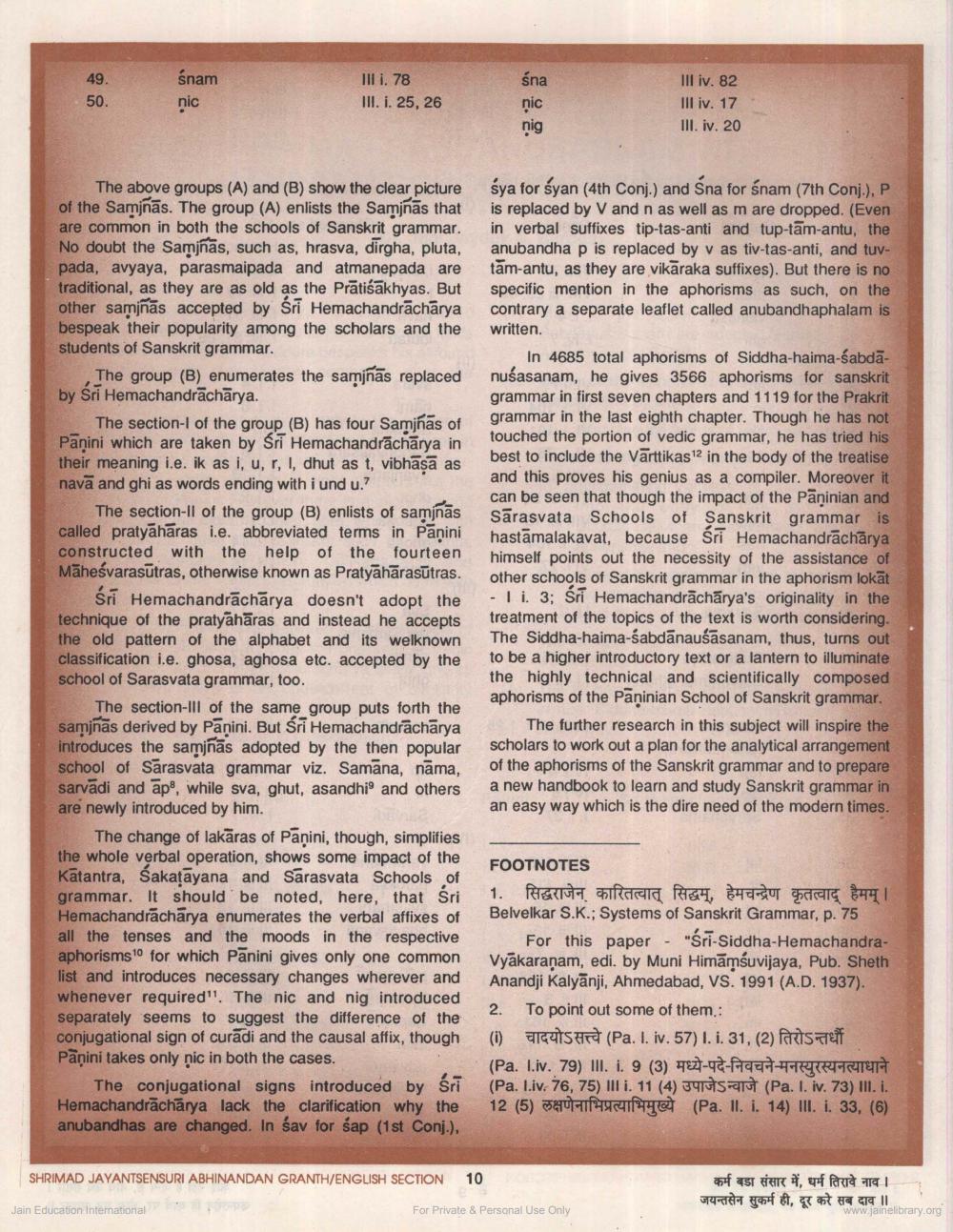________________
49. 50.
śnam
nic
III i. 78
III. i. 25, 26
The above groups (A) and (B) show the clear picture of the Saminas. The group (A) enlists the Samiñas that are common in both the schools of Sanskrit grammar. No doubt the Samiñas, such as, hrasva, dirgha, pluta, pada, avyaya, parasmaipada and atmanepada are traditional, as they are as old as the Pratiśākhyas. But other samiñas accepted by Śrī Hemachandracharya bespeak their popularity among the scholars and the students of Sanskrit grammar.
The group (B) enumerates the samiñas replaced by Sri Hemachandracharya.
The section-1 of the group (B) has four Saminas of Panini which are taken by Śrī Hemachandracharya in their meaning i.e. ik as i, u, r, I, dhut as t, vibhāṣā as nava and ghi as words ending with i und u.?
The section-II of the group (B) enlists of saminas called pratyahāras i.e. abbreviated terms in Panini constructed with the help of the fourteen Mäheśvarasutras, otherwise known as Pratyāhārasūtras.
ś Hemachandracharya doesn't adopt the technique of the pratyahāras and instead he accepts the old pattern of the alphabet and its welknown classification i.e. ghosa, aghosa etc. accepted by the school of Sarasvata grammar, too.
The section-III of the same group puts forth the saminas derived by Panini. But Sri Hemachandracharya introduces the samjñās adopted by the then popular school of Sarasvata grammar viz. Samana, nāma, sarvadi and apa, while sva, ghut, asandhi and others are newly introduced by him.
The change of lakaras of Panini, though, simplifies the whole verbal operation, shows some impact of the Katantra, Sakatayana and Sarasvata Schools of grammar. It should be noted, here, that Sri Hemachandracharya enumerates the verbal affixes of all the tenses and the moods in the respective aphorisms 10 for which Panini gives only one common list and introduces necessary changes wherever and whenever required". The nic and nig introduced separately seems to suggest the difference of the conjugational sign of curadi and the causal affix, though Panini takes only nic in both the cases.
The conjugational signs introduced by śri Hemachandracharya lack the clarification why the anubandhas are changed. In sav for sap (1st Conj.),
Jain Education International
SHRIMAD JAYANTSENSURI ABHINANDAN GRANTH/ENGLISH SECTION
śna
nic
nig
sya for syan (4th Conj.) and Sna for śnam (7th Conj.), P is replaced by V and n as well as m are dropped. (Even in verbal suffixes tip-tas-anti and tup-tam-antu, the anubandha p is replaced by v as tiv-tas-anti, and tuvtam-antu, as they are vikaraka suffixes). But there is no specific mention in the aphorisms as such, on the contrary a separate leaflet called anubandhaphalam is written.
Ill iv. 82
Ill iv. 17
III. iv. 20
In 4685 total aphorisms of Siddha-haima-sabdanuśasanam, he gives 3566 aphorisms for sanskrit grammar in first seven chapters and 1119 for the Prakrit grammar in the last eighth chapter. Though he has not touched the portion of vedic grammar, he has tried his best to include the Varttikas12 in the body of the treatise and this proves his genius as a compiler. Moreover it can be seen that though the impact of the Paninian and Sarasvata Schools of Sanskrit grammar is hastamalakavat, because Sri Hemachandracharya himself points out the necessity of the assistance of other schools of Sanskrit grammar in the aphorism lokāt - I i. 3; Śrī Hemachandracharya's originality in the treatment of the topics of the text is worth considering. The Siddha-haima-sabdānausāsanam, thus, turns out to be a higher introductory text or a lantern to illuminate the highly technical and scientifically composed aphorisms of the Paninian School of Sanskrit grammar.
The further research in this subject will inspire the scholars to work out a plan for the analytical arrangement of the aphorisms of the Sanskrit grammar and to prepare a new handbook to learn and study Sanskrit grammar in an easy way which is the dire need of the modern times.
1.
FOOTNOTES
सिद्धराजेन कारितत्वात् सिद्धम्, हेमचन्द्रेण कृतत्वाद् हैमम् । Belvelkar S.K.; Systems of Sanskrit Grammar, p. 75
For this paper "Sri-Siddha-HemachandraVyakaranam, edi. by Muni Himamsuvijaya, Pub. Sheth Anandji Kalyanji, Ahmedabad, VS. 1991 (A.D. 1937).
2.
To point out some of them.:
(i) चादयोऽसत्त्वे (Pa. I. iv. 57) 1.1.31. (2) तिरोऽन्तर्धी (Pa. I.v. 79) III. 1. 9 (3) मध्ये पदे- निवचने-मनस्युरस्यनत्याधाने (Pa. l.iv. 76, 75) III i. 11 (4) 3 (Pa. I. iv. 73) III. i. 12 (5) लक्षणेनाभिप्रत्याभिमुख्ये (Pa. II. 1. 14) III. 1. 33, (6)
10
For Private & Personal Use Only
कर्म बडा संसार में, धर्म तिरावे नाव । जयन्तसेन सुकर्म ही, दूर करे सब दाव ॥
www.jainelibrary.org




